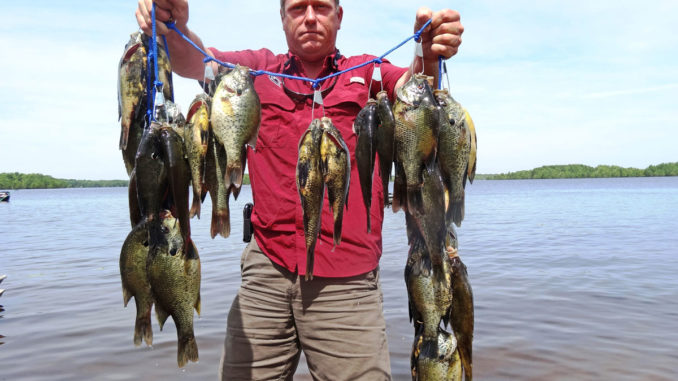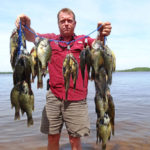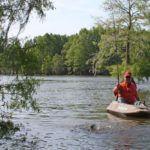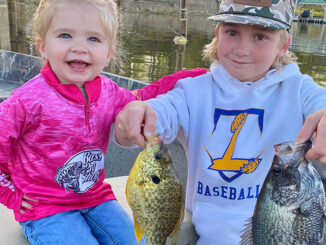
Santee Cooper shellcrackers peak in April
It’s shellcracker time on the Santee Cooper lakes, and anglers show this panfish species a lot of love in April. These brawny bream returns the favor by filling up empty space in large coolers. Anglers know long waiting lines to launch a boat even at remote access areas signals shellcracker action is smoking hot.
Santee Cooper anglers of all pursuits dream about April because most gamefish and panfish species are in shallow water either feeding, spawning or both. Excellent fishing exists as trophy largemouth bass, slab crappie, giant catfish, spawning stripers and even bull bream kick off the bedding season.
But the world-class shellcracker fishing produces an overflow of anglers to the shallow sectors of both lakes.
It’s with good reason, because Santee Cooper is one of the top shellcracker fisheries in the world. The state record — and one-time world record — is a 5-pound, 71/2-ounce fish caught in the Diversion Canal in 1998.
Shellcrackers, aka redear sunfish, are popular on both lakes, with the largest area of heavy-duty shellcracker action typically in the upper end of Lake Marion above the I-95 bridge. Also, the outlets to shallow water along and in the Diversion Canal and the shallow water areas ringing Lake Moultrie are excellent.
Two Lake Marion fishermen, Hilton Fulmer and William Scott, have targeted shellcrackers as a team for 12 years and more than 35 years individually. They’ve watched the ebb and flow of the fishery from aquatic growth changes and have adapted. Like many, they’ve developed a strong passion for these sunfish.
“Shellcracker fishing the past few years has been awesome,” Fulmer said. “The pressure is heavy, but the fishery is holding up. The key is to get in the right habitat to find them in big numbers. Good examples are around cypress trees, stumps, logs and different types of vegetation. Fish an area thoroughly, but stay on the move until you hit a hot spot. I fish shallow, usually 1 to 3 feet, under a small bobber.”
Scott said to find an area and learn it well.
“The better I learn an area, the more effective shellcracker fisherman I am,” he said. “We typically catch lots of shellcrackers well over a pound, and it’s not unusual to get on a bed of huge shellcrackers weighting from 1 to 2 pounds apiece. We occasionally catch them considerably larger, and 3-pound fish are the exception, but not unrealistic. A good shellcracker bed produces action as quick as the float hits the water. It’s worth every minute you invest in finding that spot.”
Scott said even when the shellcrackers aren’t bedding, they still catch limits in staging areas.
“A good staging area for shellcrackers is 2 to 3 feet of water with cover nearby, but not far from deeper water,” Scott said. “If the water conditions change or a front blows through, they can retreat to deeper water. Big shellcrackers stage in these areas, and the fishing is not quite as fast-paced as bed fishing, but limits of quality fish are still available.”
Fulmer said when fishing for staging shellcrackers, most of the time they will catch several from a spot, then move to another area and repeat the process.
“They’re not all piled into a small area like when they’re bedding, but you can still catch a limit of big fish in a fairly short period of time,” he said. “The key is to move and work around cover until you catch a fish or two and then work that immediate area. Do this when they’re on the beds (and) you’ll likely catch a limit from that one spot. When they’re staging, you just have to move around a bit more.”
Fulmer uses a 10-foot rod with a fly reel loaded with 6-pound test line. He pairs that with a small float and BB split-shot and a No. 6 long-shank hook. He often uses a sneak boat so he can maneuver around the trees.
Scott prefers 10-pound line and will occasionally use a sneak boat, as well as a small john boat.
“Line size is a trade-off,” Scott said. “The light line may produce more bites, but I feel I have a better chance to land a really big fish. It’s personal preference as to what any specific fisherman should do.”
Fulmer said that both worms and crickets will produce shellcrackers, but when he targets them specifically, he uses nothing but red worms.
“For shellcrackers, I hook my red wiggler worm once through the head and let it dangle straight down,” Fulmer said. “I don’t gob the worms on the hook, and I believe it makes a big difference. Plus, I think big red wigglers out produce night crawlers.”
Fisheries biologist Scott Lamprecht, who oversees the Santee Cooper lakes for the S.C. Department of Natural Resources, said the reason shellcrackers get so big on Lake Marion and Lake Moultrie, is a combination of age and ideal habitat.
“One primary reason shellcrackers get so large here is they live a long time, longer than most panfish,” Lamprecht said. “Shellcrackers can live over 10 years; a bluegill may live five years. Another plus is the habitat and food supply in the Santee Cooper system is ideal for growing shellcrackers. Food sources include mussels, clams and snails as well as insect larva and other benthic invertebrates, all found in great supply. Shellcrackers thrive in shallow, moving water with, food rich environments, exactly what occurs here.”
Lamprecht said every spring, biologists see a number of 3-pound shellcrackers and usually some 4-pound fish. That’s big shellcrackers anywhere.
Individual shellcrackers generally bed once a year, but not all at the same time; some spawn a bit early and some later.
“Typically a full moon during late April is the peak, but some bedding usually occurs a month earlier and a month after the peak,” Lamprecht said. “This gives shellcracker fishermen an extended spawning season.”





Be the first to comment